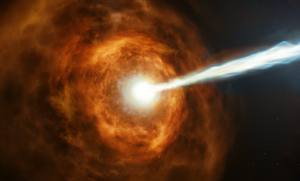Blog
The Flash
20 November 2019
 NASA, ESA, and M. Kornmesser
NASA, ESA, and M. KornmesserGamma-Ray Bursts (GRBs) are incredibly bright flashes of gamma-ray light. Within only a few seconds they can release more energy than the Sun will emit in its lifetime. About 30% of them are short bursts, lasting less than two seconds. The other 70% are long bursts and can last up to a couple of hours. The tremendous power and short duration of GRBs make them difficult to study, but recent observations1 have helped us understand how they occur.
In January 2019, the Swift and Fermi gamma-ray telescopes observed a record-holding burst named GRB 190114C. Some of the light emitted had the highest energy ever observed. To study just how such powerful light could have been created, follow-up observations in visible light were made by the Hubble telescope. In studying the environment around the GRB, they found it occurred in a dense region of a galaxy. This could explain the unusually high energy burst.
Although gamma rays were first detected in radioactive decay, in space they are often produced material collides at relativistic speeds. Given the energy of the observed light, it was likely caused when matter traveling at 99.999% of light speed collided with the surrounding dense gas.
Such relativistic beams of matter are produced when a large star dies. As the core collapses into a black hole, high energy beams of matter radiate away from the axis of rotation. So it is likely that the GRB marks the formation of a stellar black hole.
What is interesting about this work is that it demonstrates the importance of the surrounding environment. If it had occurred in a more diffuse region of space, it would not have been nearly as bright.
MAGIC Collaboration, P. Veres, et al. “Observation of inverse Compton emission from a long γ-ray burst” Nature volume 575, pages459–463(2019) ↩︎